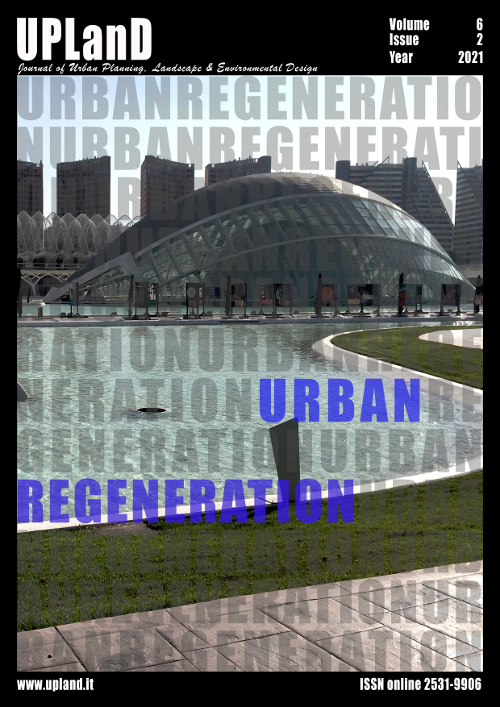The former Kerasav factory in Portici. New perspectives on the City.
Main Article Content
Abstract
The research focuses on the conservation and restoration project of the former Kerasav ceramic factory in Portici, Italy. The architectural restoration project lays its foundations on a thorough understanding of the existing buildings’ specificities with a view to transmitting them to the future. In this respect, an accurate historical research provided the background knowledge for the requalification strategy reviewed in this paper. The study focuses both on the technical characteristics of the peculiar trussed beams of the former Kerasav and on the role that the latter can play within its context, imagining it as a new urban hub. The goal is to develop an industrial rehab project that responds to the urban planning requirements outlined in the Strategic Urban Development Plan, with particular attention to preserving the memory of the industrial heritage within the Vesuvian territory. The debate on the enhancement of brownfield sites and the opportunities they offer to their urban contexts has become increasingly important in re-cent years. The need to keep widening the field of research without limiting it to single artefacts is the leitmotif that led the research, taking into account their social, environmental and historical values, as well as their small and large-scale potential, in order to deliver a tailor-made urban regeneration proposal for the densely inhabited city of Portici. Furthermore, preventing these artefacts from turning into "something else" by respecting their industrial memory through a set of interventions capable of establishing an effective dialogue between past and present.
Downloads
Article Details

This work is licensed under a Creative Commons Attribution-NonCommercial-NoDerivatives 4.0 International License.
Authors who publish with this journal agree to the following terms:- Authors retain copyright and grant the journal right of first publication with the work simultaneously licensed under a Creative Commons Attribution License that allows others to share the work with an acknowledgement of the work's authorship and initial publication in this journal.
- Authors are able to enter into separate, additional contractual arrangements for the non-exclusive distribution of the journal's published version of the work (e.g., post it to an institutional repository or publish it in a book), with an acknowledgement of its initial publication in this journal.
- Authors are permitted and encouraged to post their work online (e.g., in institutional repositories or on their website) prior to and during the submission process, as it can lead to productive exchanges, as well as earlier and greater citation of published work (See The Effect of Open Access).
References
Aveta, A., Casiello, S., La Regina, F., Picone, R. & Casiello De Martino, S. (2005). Restauro e consolidamento: atti del convegno Restauro e consolidamento in beni architettonici e ambientali. Problematiche attuali, Napoli, 31 marzo – 1 aprile 2003. Roma, IT: Mancosu.
Barazzetta, G. (2017). Pier Luigi Nervi: il modello come strumento di progetto e costruzione. Macerata, IT: Quodlibet.
Boltri, D. (1998). Architetture olivettiane a Ivrea: i luoghi del lavoro e i servizi socio assistenziali di fabbrica. Roma, IT: Gangemi
Cavallotti, C. (1969). Architettura industriale. Milano, IT: Gorlich.
Ciuffetti, A., & Parisi, R. (2012). L’archeologia industriale in Italia: storie e storiografia 1978-2008. Milano, IT: Franco Angeli.
Colombo, L. (1998). Le aree industriali dismesse e il caso Bagnoli. Napoli, IT: Miscellanea Civitas.
Coppola, L., Buoso, A., & Pizzogni, A. (2015). Il restauro dell’architettura moderna in cemento armato: alterazione e dissesto delle strutture in c.a., diagnostica, interventi di manutenzione e adeguamento antisismico, materiali, tecniche e cantieristica. Milano, IT: Editore Ulrico Hoepli.
Cupelloni, L. (2011). Archeologia industriale e periferia urbana. Due casi di progettazione tecnologica ambientale. Firenze, IT: Firenze University Press.
Dansero, E., Giaimo, C., & Spaziante, A. (2001). Se i vuoti si riempiono: aree industriali dismesse. Temi e ricerche. Firenze, IT: Alinea Editrice.
Dirinidin, R. (2010). Lo stile dell’ingegneria: architettura e identità della tecnica tra il primo modernismo e Pier Luigi Nervi. Venezia, IT: Marsilio.
Dweik, Ghassan J.M., Mazzoleni, D. & Picone, R. (2018). Historic centres and identity: enhancement and restoration between Italy and Palestine. The case of Hebron. Napoli, IT: Arte’m
Gargiulo, C. (2001). Processi di trasformazione urbana e aree industriali dismesse: esperienze in atto in Italia. Venezia, IT: AUDIS.
Genovese, R.A., & Gazaneo, J. (1982). Archeologia industriale in Campania alla fine del XIX secolo. Napoli, IT: Edizioni scientifiche italiane.
Hudson, K., & Covino, R. (1981). Archeologia industriale. Bologna, IT: Zanichelli.
Ientile, R. (2008). Architetture in cemento armato: orientamenti per la conservazione. Milano, IT: Franco Angeli.
Mannini, G., Rosa, G., & Sajeva, A. (1981). Archeologia industriale. Firenze, IT: La Nuova Italia.
Natoli, M., Sperandio, A., & Muratore, G. (1999). L’archeologia industriale nel Lazio: storia e recupero. Roma, IT: Fratelli Palombi.
Negri, A., & De Seta, C. (1983). Archeologia industriale: monumenti del lavoro tra XVIII e XX secolo. Milano, IT: Touring Club Italiano.
Papuli, G. (1997). L’ingegno e il coraggio: archeologia industriale e cultura eclettica. Lecce, IT: Edizioni del Grifo.
Parisi, R. (2011). Fabbriche d’Italia: l’architettura industriale dall’unità alla fine del secolo breve. Milano, IT: Franco Angeli.
Picone, R. (2008). Conoscenza e conservazione di un’opera del moderno: il restauro dell’ex fabbrica Cirio a Napoli. In Ientile, R. (Ed.), Architetture in cemento armato. Orientamento per la conservazione (pp. 444-452). Milano, IT: Franco Angeli.
Piva, A. (1983). La costruzione del museo contemporaneo: gli spazi della memoria e del lavoro. Milano, IT: Jaca Book.
Piva, A., Caputo, P., & Fazzini, C. (1979). L’architettura del lavoro; archeologia industriale e progetto. Venezia, IT: Marsilio.
Pucinotti, R. (2005). Patologia e diagnostica del cemento armato: indagini non distruttive e carotaggi nelle opere da consolidare. Palermo, IT: Flaccovio.
Ronchetta, C., & Trisciuglio, M. (2008). Progettare per il patrimonio industriale. Torino, IT: Celid
Rubino, G.E. (2004). Le fabbriche del Sud: architettura e archeologia del lavoro. Napoli, IT: Giannini Editore.
Rubino, G.E., & Venditti, A. (1978). Archeologia industriale e mezzogiorno. Roma, IT: Mario Giuditta.

